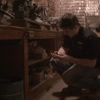A South-of-the-Border Search for Jewish Identity
Written by Ilan Stavans | Posted by: Anonymous
In my view, complaints about a film misrepresenting the
source on which it is based miss the point. Once a writer sells the material
and agrees to no longer be involved, the product is beyond his domain. He might
as well sit back and enjoy the show, just like any other spectator.
A few years ago, Alejandro Springall came to visit me at
Amherst College. He dreamed of making a film about Mexican Jews and wanted me
to write the story. I was intrigued by the invitation: I’m always in need of
exploring with new forms; plus, I’m an unredeemed film buff. In fact, when I
was an adolescent I seriously considered — as “seriously” as one does at that
age — pursuing filmmaking as a career. Springall and I spent hours together at
a Holiday Inn, including pulling an all-nighter, mainly sharing our experiences
of growing up in Mexico City, a megalopolis today of about 18 million people
where Jews constitute less than 0.1 percent of the population.
Yet the tightly knit, complex, entrepreneurial Jewish
community has solid roots, as is evident in thriving neighborhoods such as
Condesa, Polanco and Tecamachalco, and in institutions like the Kehila, the
Yiddish and Hebrew day schools, the legendary sports center, mikvehs and
cemeteries, and its various youth organizations. Its ancestry isn’t exclusively
Eastern European, though; there are a significant portion of members identifying
themselves as Sephardic, with ancestry in Syria, Turkey and Lebanon. Some still
speak Ladino.
I didn’t know Springall before this, though I had admired
his 1999 movie Santitos. He isn’t Jewish, but he told me about dating
Jewish girls and feeling at home in their milieu. Should a movie come from it,
I remember telling myself during our tête-à-tête, it would have the perspective
of an affectionate outsider, which is more than fitting, given that Mexican Jews
in my view retain a sense of uniqueness that makes them stand apart. We signed
an agreement, and months later I sent Springall the first draft of Morirse
está en hebreo, a 90-page-long novella that was eventually collected in my
book The Disappearance.
Springall’s film, also called in Spanish Morirse está en
hebreo and titled in English My Mexican Shivah, screens this month at
the Hartford Jewish Film Festival. Co-produced by John Sayles and with an
original score by The Klezmatics, it has a cast of theater and soap opera actors
that includes my father, Abraham Stavans. The film was shot in a Polanco
apartment like the one in the story. (I visited the set and even had a cameo
appearance.) It belongs to the growing shelf of south-of-the-border movies
about Jewish topics, from The Holy Office, about the 16th-century auto-da-fé
of Luis de Carvajal the younger, to The Lost Embrace, about
Argentine-Jewish angst.
Aside from a brief opening and a funeral at the Ashkenazic
panteón, the plot was Aristotelian in its structure. It’s about the death of
Moishe Tartakovsky, a patriarch in the Ashkenazic community. Unfolding in the
background are the presidential elections of 2000, in which the ruling party,
Partido Revolucionario Institucional (PRI), finally lost after holding on to
power for 70-plus years. The candidate that replaced PRI ruler President
Ernesto Zedillo wasn’t from a left-wing party, like Andrés Manuel López Obrador,
who, speaking for the Partido Revolucionario Democrático in the elections of
2006, claims that, despite his defeat, he is Mexico’s rightful president. The
winner in 2000 was Vicente Fox, a former Coca-Cola executive from the
conservative Partido de Acción Nacional. The nation’s democracy was still
untested then. Maybe the word is immature.
Immature is how I’ve at times felt we Mexican Jews perceive
ourselves. Anti-Semitism is always latent in Mexico. It has been supported by
the Catholic Church and by certain extremist ideological factions since colonial
times. But the Jewish community ignores it, preferring to look inward. It’s
just as well, since my intention in Morirse está en hebreo wasn’t to
dwell on the political sphere per se. Without ignoring the larger national
scene, I wanted to write an intimate portrait, a chamber piece, concentrating on
the domestic side of a single family; the Tartakovskys would serve as a
microcosm of a Diaspora that happens to be my own.
What has made each chapter of the Jewish Diaspora, from the
destruction of the First Temple in Jerusalem to the present, different? The
fact that, like chameleons, we Jews “adapt and adopt,” as a teacher of mine
enjoyed saying; we assimilate to the environment by incorporating elements of
that environment into our Weltanschauung. A seller of leather, the
character Moishe
Tartakovsky’s personality is built around the dilemma of being a member of a
small minority in a country monolithically Catholic. Why does he constantly
feel like a traitor? Is Mexico his real home?
Since the 1970s, writers in Latin America have been
pressured to conform to the magic realism made famous by Gabriel Garcia Márquez
and others. While I’ve been interested in the style, I’ve resisted being
enlisted into its ranks. It might be seen as ironic, then, that between the
time I sent Springall the draft and its final publication, an uncle of mine,
Abraham Slomianski, also a family patriarch, died exactly the same death I had
imagined for Tartakovsky. Talk about literature as a way of life, or else about
life as a way to literature.
In any case, before he died, Tartakovsky’s family — his
two children, Bernardo (aka Berele) and Esther; his grandchildren, Nicolás, Ari
and Galia; his close friends and associates; his school sweetheart; the shiksa
who was his lover; the maid, et al. — approached him as the glue keeping
everyone together, for better or worse. They saw him either as idol or as
villain, received either his gifts or his scorn. But they hardly spent any time
together as a family unless he was around. So with his death, they faced a
challenge: What would keep them together now? And did they all see Tartakovsky
through the same lens? Was he a chameleon even among Jews? I wrote the novella
in English with portions in Yiddish and Hebrew. The tone is humorous, although
it isn’t outright comedy.
Sadly, the political dimension was left out. The film
isn’t a reflection on the perils of young democracies and the role that
minorities play in them. There are mariachis, paramedics and other supporting
figures, but they are marginal. Springall also endorses the symbolic, a
decision I applaud. Two bearded Hasids — played by a pair of excellent amateur
actors — take the function of a Greek chorus, offering insight into the story
through comments delivered in the Yiddish I grew up with (but with subtitles, of
course). But his adaptation is less than subtle, emphasizing the role I barely
insinuated for my characters.
I have no regrets, though. It is at once exciting and
strange to see my fictions transposed onto the big screen. Springall turns the
material into comedy by stressing the exoticism that results from Jews and
Mexicans seated together in shiva. To me there isn’t much exoticism there, only
a mundane relationship based on centuries of misunderstanding. Art is about
letting loose, about breaking boundaries, about usurping what isn’t ours. In
the novella Morirse está en hebreo, I sought to exorcise some of the
demons of my past, to place them in historical context. I visualized myself in
Tartakovsky’s shiva. What I mourned was the ambivalence of Mexican Jews during
the PRI years. Springall reinterprets the material in an exaggerated manner,
one suitable in cinematic terms.
This time around, I’m the outsider.
This article is
published courtesy of Ilan Stavans. It originally appeared in
The Forward. My Mexican Shiva screens on March 27th at 7:30
pm as part of the
Hartford
Jewish Film Festival.












